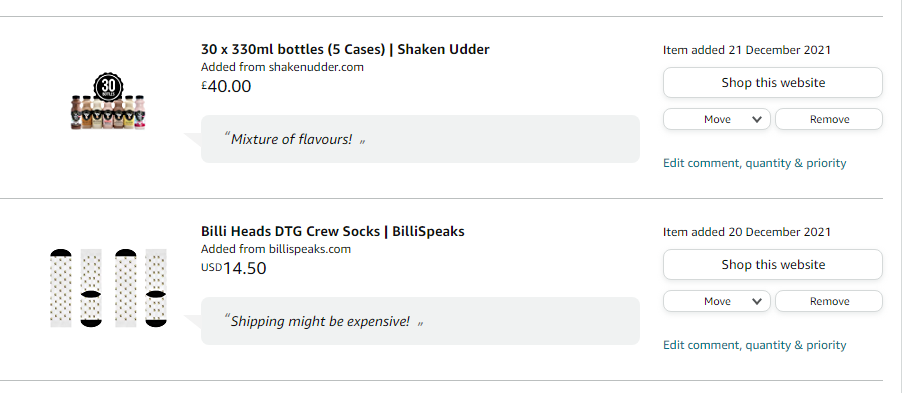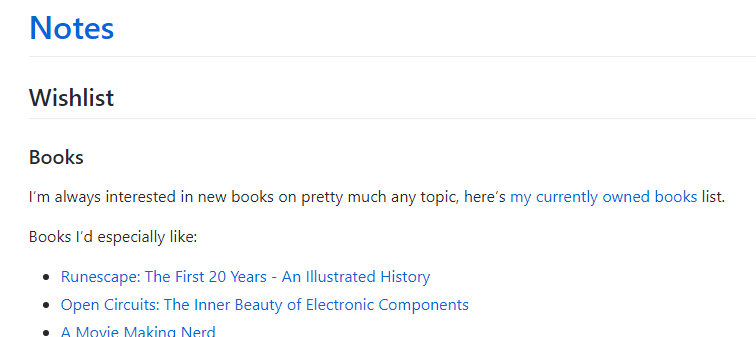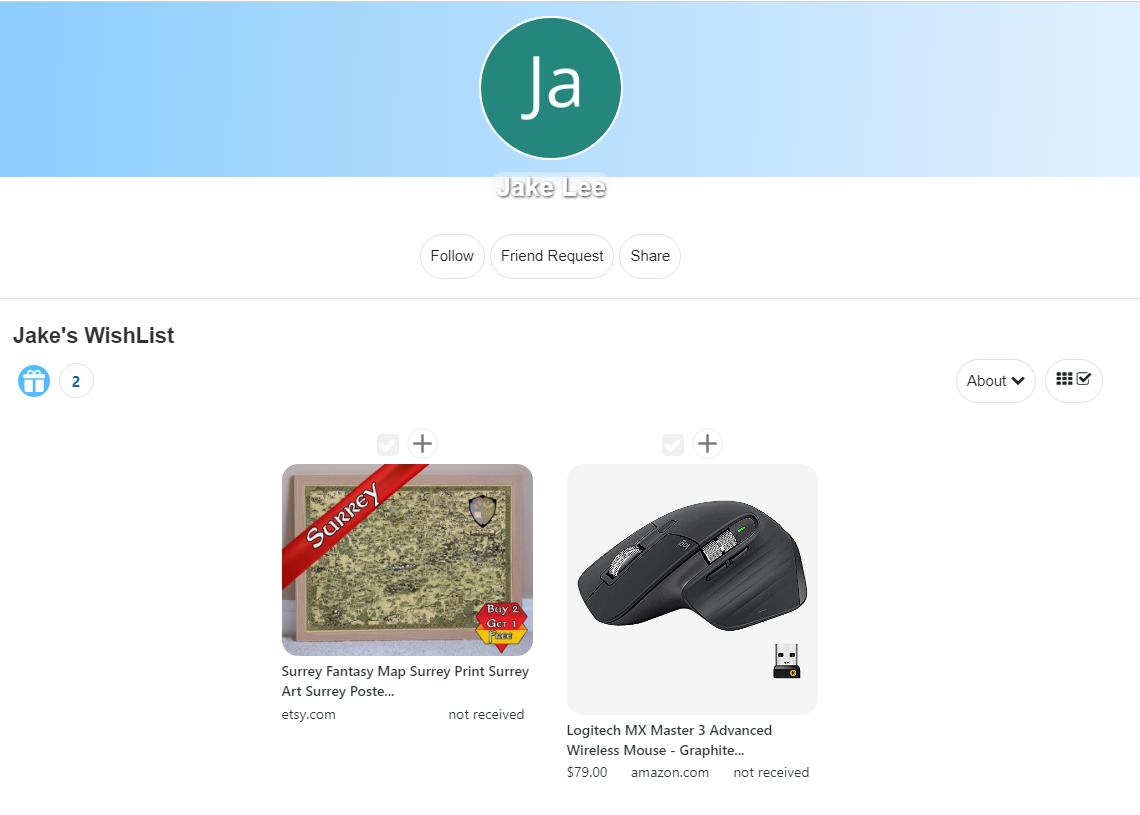
Had enough of Amazon wishlists? Here's a comparison of alternative services!
For many years I’ve had a public Amazon wishlist that I can share with friends & family. I add to it throughout the year, and it lets people buy me things I’ll definitely love. This has worked well, but recently Amazon removed support for third party products… so here’s where to migrate to.
Here’s what my ideal wishlist site would have:
- Ability to easily add new items.
- Able to share the list publicly, ideally with a simple URL.
- No adverts / cost / distracting UI.
Amazon wishlists
Whilst Amazon sells a lot of things, about half my list is from third party sites. This might be gift cards for local stores, handmade items from Etsy, or fan merchandise like a Starbase mug. Previously it was possible to add these items to Amazon wishlists with the “Amazon Assistant” extension, however this was disabled in March 2023.
Here’s how these non-Amazon items looked, complete with helpful comments:
Losing this functionality is a real shame, and lots of other customers miss the functionality too. I can only assume the change is to encourage customers to only purchase Amazon products, or perhaps it was only being kept around as an incentive to use the “Amazon Assistant” extension. Personally this feels a bit of an aggressive move, so I’m moving to an alternative service instead!
Whilst none of these alternatives can perfectly recreate Amazon’s ability for strangers to order gifts without knowing my address, hopefully their other benefits make up for this trade-off.
Summary: Perfect for Amazon items, useless for non-Amazon items.
Notion wishlists
I use Notion extensively at work, and have used it for personal planning before. I created a basic wishlist and made it public, which is free and works. Notion’s main advantage is that it’s very easy to use, and has all the formatting and text editing functionality you’d expect.
However, Notion doesn’t support custom domains, and it also feels like an unnecessarily complicated web app for just showing a simple list of items in this use case. The design is pretty attractive, but there’s a “Try Notion” advert on the screen, and the URL is pretty unappealing: https://jakeleeuk.notion.site/jakeleeuk/Wishlist-97f0850bd047447ea0430ab7d5eba948.
Here’s how a few items from the wishlist look:
Summary: Easy to set up and use, but perhaps overkill.
GitHub wishlists
So, I’ve figured out that a plain list of links is good enough for me. Notion was a bit too complex, so what about old reliable Markdown files?
By editing a wishlist.md file in a brand new Notes GitHub Pages repo, I get all the advantages of Markdown and GitHub as well as a simple sharable wishlist: https://notes.jakelee.co.uk/wishlist.html.
If you haven’t used GitHub Pages before there’s a quickstart guide, it’s definitely the cleanest way to host simple text-based content. The only downside is that there’s zero possibility of fancy embeds for items, or any functionality beyond plain text. For me this is OK, but not showing the prices / images definitely makes the buyer’s experience worse.
Note that Notion pages can be exported as Markdown via ... -> Export, massively simplifying the transfer.
Here’s how the plain text looks on a GitHub Pages site:
Summary: Tricky to set up, but convenient for existing GitHub users.
MyWishlist.online
I was initially hesitant to use a generic wishlist service, since I assumed they’d have to use advertising to exist. However, MyWishlist.online instead uses affiliate links for sites like Amazon. Realistically this is probably the best approach, as there’s no negative impact to the list maker or gift purchaser, whilst ensuring the service can exist.
Making a list was nice and easy, with the shareable list having a simple design and URL (https://mywishlist.online/w/oht1wy/jakes-wishlist). I really appreciated how item searching and URL adding is supported, with item metadata being pulled from any entered URLs. This is pretty much a better version of the old Amazon Assistant, even down to the associated Chrome extension. The final wishlist was minimalist yet appealing, a major selling point:
Summary: Very user-friendly, but provided by a random individual.
ThingsToGetMe.com
ThingsToGetMe is a much simpler offering in terms of core wishlist functionality, but has more add-ons. For example it can’t search for products or add from URL, requiring manual entry of all data, and unable to even pull images from Amazon.
However, it also offers unexpectedly advanced features such as “Money funds” for collecting actual money, styling the wishlist with almost 80 themes, and collaborating with others on a wishlist. All of this doesn’t even require creating an account, one more positive attribute. Additionally, it supports importing from an existing wishlist, massively simplifying any migration process:
Overall ThingsToGetMe is a really impressive offering, and seems to have a dedicated (but small) team behind it. Whilst this isn’t essential, trusting your wishlist to a real company helps reduce the risk of anything happening to the data in the future.
The only potential downside is hinted at by their suspiciously generous referral program. They seem to offer £2-3 per referral, which for a free service seems absurd. This, combined with all the blog posts, advanced features, money pool support, and even an app raises the question of where is the money coming from? The “About us” page doesn’t offer any clues, and a donation model can only work if the referral program is currently mostly unused!
Regardless, here’s how my wishlist looks:
Summary: The highest quality wishlist service overall, with the only downside being the funding mystery.
Wishlist.com
With a URL like that, it must be good right? Well, kind of. Whilst Wishlist.com offers basic wishlisting tools, it feels very mid-2000s. The UI is all over the place, searching for items only seems to search Amazon USA, and it clearly expects users to enter most of the data manually.
Ultimately there isn’t much to say about the site, it’s essentially a slightly trickier to use version of MyWishlist.online. The monetisation model doesn’t seem to be explained anywhere, but their reliance on Amazon product searches strongly suggests it’s also through referral links.
Here’s my simple wishlist, adding products was a bit too painful to do more!
Summary: Not very fun to use, but does all the wishlisting basics.
Conclusion
Overall, there’s plenty of Amazon wishlist alternatives that are worth using, unfortunately none of which can offer anonymous gift purchasing. I’d recommend ThingsToGetMe.com as meeting most people’s needs, without any limits. Personally I went for a GitHub repo since I already use GitHub heavily, with my wishlist now living at https://notes.jakelee.co.uk/wishlist.html.






